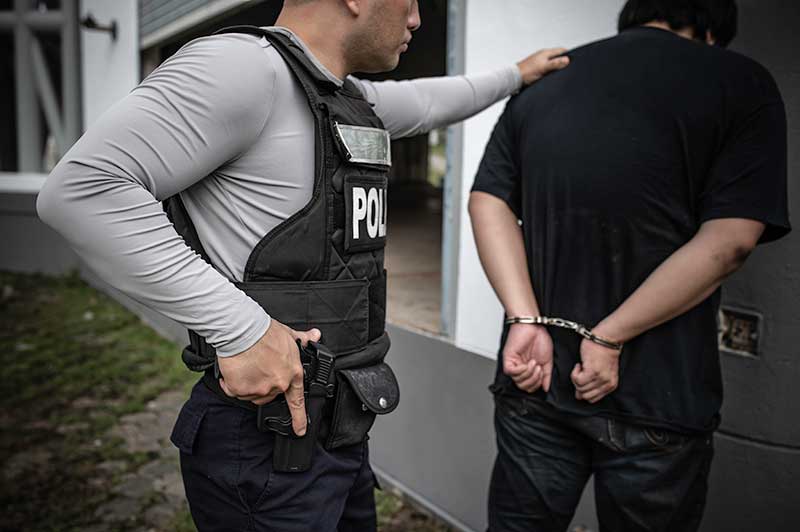Exploring legal alternatives to immigrant detention is vital in a system that continues to resort to confinement, even when no crime is involved.
Our immigration attorneys in Los Angeles are thoroughly familiar with these options and can help you find more humane and effective solutions for your case.
If you or a loved one is facing immigration proceedings, we are here to defend your rights with commitment and experience.
LATINOS WITH OVER 60 YEARS EXPERIENCE
Tell Us Your Case
Table of Contents
What are the current legal alternatives to immigrant detention in the US?
In the United States there are legal alternatives that allow immigrants to pursue their case without being deprived of their liberty. Among the main options are:

- Parole: The immigrant is released without additional conditions.
- Freedom under specific conditions: Such as reporting periodically to US Immigration and Customs Enforcement (ICE) or following certain rules.
- Immigration bail: Allows you to obtain freedom by paying a set amount.
- Intensive supervision programs: These include monitoring with electronic shackles, facial recognition, or voice verification calls.
- Community Supervision: Provides referrals and support, although it is still limited in scope.
- Pilot Programs: There are certain programs run by non-governmental organizations that provide legal, social, and medical support without relying on ICE.
Who is eligible for an alternative to immigration detention?
Not all detainees are eligible for alternative detention. These measures typically apply to immigrants who:
- They do not pose a threat to public safety or a flight risk.
- They have family or community ties in the US.
- They are seeking asylum in the USA or other immigration relief .
- They have no serious criminal record.
- They are responsible for the care of citizen children or dependent persons.
The decision to apply for these alternatives depends on ICE or the immigration judge, depending on the stage of the case.

Looking to learn how to prepare for your asylum interview in court? In this guide, we’ve explained what to expect during the hearing, what documents to gather, and how to respond clearly and coherently to strengthen your case.
How can I request an alternative to immigration detention?
The way to request an alternative varies depending on whether you are already detained or under immigration supervision .
If you are detained
Your attorney may request a bond hearing before an immigration judge or file a parole application, depending on the case.
To support the request, it is essential the following:
- Submit evidence;
- Have family ties;
- Have good conduct;
- There must be humanitarian reasons .
If you are under supervision
If you have an electronic anklet, you can request a modification to the current conditions.
This includes reducing the frequency of your appearances or requesting the device be removed. Your attorney can submit the formal request directly to ICE.
What factors are taken into account when accessing an alternative to detention?
Both ICE and the immigration judge will evaluate several factors before granting alternative relief. Some of the most relevant factors are:
- Your criminal and immigration history.
- The time you have lived in the United States.
- If you have citizen children or dependents.
- Their participation in the community and employment situation.
- The strength of your immigration case (such as asylum, U visa, VAWA, or other type of relief).
It’s essential to understand that a U visa can be denied for a variety of reasons. Learn the most common reasons for denial and how to best prepare your application to increase your chances of approval.
What advantages do these alternatives have?
Opting for an alternative to detention allows you to:
- Stay with your family while your case is resolved.
- Avoid the emotional and economic impact of being detained.
- Better prepare your legal defense.
- Continue working if you have an employment authorization.
Note: Want to know how to protect your labor rights as an immigrant? We’ll show you the keys to identifying your legal rights, avoiding workplace abuses, and defending yourself against any injustice.
How many Individuals are currently detained?
As of July 2025, more than 56,000 individuals were in ICE custody in the United States.
Of these, 71% had no criminal convictions, and many of those who did have prior convictions were for minor offenses.
Do you know how to deal with ICE? Staying calm and knowing your rights is key to protecting yourself during any encounter with immigration authorities. We explain what to do and what to avoid to handle this situation safely and with legal support.
In which states are there the most people detained by ICE?
The states with the most detainees are:
- Texas (13,087);
- Louisiana (7,379);
- California (3,471);
- Georgia (2,900); and
- Arizona (2,594).
These data reflect averages, so the actual number may have increased significantly.
Does the government cover the legal fees of detained immigrants?
Unfortunately, there is no right to a public defender in immigration courts.
In fact, in 2024, no funding was allocated to legally represent adults, except for a limited pilot program for people with mental disabilities.
Therefore, more than 70% of detainees face their proceedings without an immigration attorney.
Frequently Asked Questions About Legal Alternatives to Immigration Detention

How much does it cost to detain an immigrant?
The average daily cost is typically around $165 per individual. In 2024, Congress allocated $3.4 billion to detain a daily average of 41,500 foreigners.
How much does an alternative to detention cost?
Among the most common alternatives to detention are the ISAP program, which costs $8 per person per day, and the Case Management Pilot program, which costs an average of $14 per day.
What about deaths in custody?
ICE publishes death notices, but there may be reporting delays and unrecorded deaths of individuals released in serious medical conditions.
In these times, ensuring the protection of migrant minors in the U.S. is more important than ever. Learn about the laws and mechanisms that seek to safeguard their safety, well-being, and rights amid the challenges of the immigration process.
How can we help immigrants learn about legal alternatives to immigrant detention available in the United States?
Facing immigration detention in the United States can be an overwhelming and uncertain experience.
With over half a century of combined experience, attorneys David and Ramiro Lluis have helped countless people learn about and pursue legal alternatives to immigration detention.
Don’t face this process alone. Call us today for a personalized evaluation of your case to find the best possible strategy.
LATINOS WITH OVER 60 YEARS EXPERIENCE
Tell Us Your Case



